In this article, we have compiled the striking and rare purple colored creatures and objects found in nature.
In this colorful journey full of purple things, you will witness the beauty of purple, from flowers to animals, from fruits and vegetables to stones and minerals. Come on, let's get lost together in this magical world of colors!
Flowers
Purple flowers represent a magical hue of nature's amazing color palette. These elegant and impressively colored flowers create a majestic atmosphere in gardens and natural settings. While the dazzling beauty of purple flowers symbolizes romance and nobility, they also offer a mysterious and deep energy.
Alliums
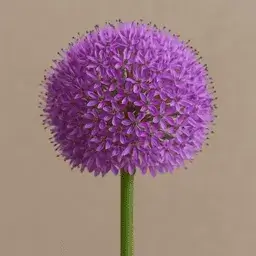
Alliums are related to common culinary herbs such as onions and garlic. Members of this family both contribute to delicious meals and impress with colorful flowers in the gardens. This family of onions with which we are familiar can surprise with their beauty in nature too!
Monarda

Monarda is a crazy group of herbs from the mint family. Originating from North America, these colorful flowers are famous for their pleasant scent and medicinal properties, reminiscent of bergamot orange. You can almost think of it as a dancing plant in nature's cocktail party!
This plant exudes a pleasant, citrus-like scent, reminiscent of the scent of bergamot orange (Citrus bergamia) in its leaves.
Agapanthus

Agapanthus is a fascinating plant, sometimes referred to as "the colorful lilies of Africa". This beauty grows in the southern regions of Africa and displays its showmanship during the summer when its flowers are blooming.
To put it playfully, members of the Agapanthus family constantly shouted at each other, "I'm bluer!" or "My purplish tones are more glamorous!" she shouts, trying to improve the color of her flowers. This riot of colors, dazzling with its blue and purple hues, Agapanthus has become a favorite of gardeners and butterflies!
Digitalis
Digitalis is a genus of about 20 species, including herbaceous perennials, shrubs and biennials, and is commonly known as the "foxtail".
Native to Europe, Western Asia, and Northwest Africa, the flowers of these plants can be tubular and come in different colors such as purple, pink, white, and yellow. It is one of the most eye-catching among purple flowers.
Leather flower
Leather flower is an ornamental plant with a variety of species and belonging to the Ranunculaceae family. These plants, mostly of Asian origin, attract attention with their climbing structures and succulent flowers.
Commonly known as clematis, these plants thrive in sunny and moist environments. They bloom at different times in spring and summer and are used as popular ornamental plants in gardens.
Lavandula
Lavender (Lavandula) is a genus of 47 known flowering plant species in the mint family Lamiaceae. It is native to the Old World and is found in Cape Verde and the Canary Islands, from Europe to northern and eastern Africa, the Mediterranean, southwestern Asia to India.
Phacelia crenulata
Phacelia crenulata is a species of flowering plant belonging to the Boraginaceae family. Its leaves are referred to by various names such as serrated scorpion grass, serrated leaf phacelia, split leaf heliotrope and heliotrope phacelia.
It shows an antitropical distribution, being found at similar latitudes on opposite sides of the equator in North and South America.
Centaurea montana
Centaurea montana, also known as continuous cornflower, mountain cornflower, bachelor's button, montane buttercup, or mountain bluet, is a species of flowering plant in the family Asteraceae, native to Europe.
It is common in the mountainous regions of southern Europe, while it is rarer in the north. Easily escaped from the gardens, it settled in England, Scandinavia, and North America.
Hyacinth
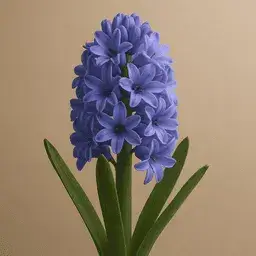
Hyacinths are beautiful and fragrant flowers that herald spring and represent the awakening of nature. Originating from the Eastern Mediterranean, this elegant plant has adorned our gardens and homes, and has also inspired many cultures and mythologies throughout history.
Hesperis matronalis
Hesperis matronalis, or marigold with its cool name, is a magical plant that brightens up gardens with its super beautiful and fragrant flowers! Originally from Eurasia, this colorful friend adorns the gardens of flower lovers all over the world.
This cheerful plant can usually grow up to 100 cm and has soft hairs on it. In spring, the colorful flowers of Hesperis matronalis bloom and enchant everyone.
Morning glory
Morning glory is a plant famous for its colorful flowers, containing more than 1000 species. Belonging to the Convolvulaceae family, these beauties are known for their early morning blooms.
Morning glory, which likes sunny environments and moist soils, is also home to night blooming flowers with some species.
Morning glory, which has been used in history for the production of medicine and rubber, is one of the indispensable ornamental plants of the gardens thanks to its rapid growth and attractive flowers.
Passion flower
Passiflora, also known as passion flower, is a genus of plants with enveloping and showy flowers with about 550 species. These plants, which are usually in the form of ivy, can sometimes be in the form of shrubs or trees.
Notable for their distinctive crown of flowers, passion flowers mature in fruit form and produce a large number of seeds. Growing in tropical regions, these plants are fertilized by various pollinators such as bees and birds and are a food source for the larvae of butterfly species.
Eryngium
Eryngium planum with purple flowers is also known as blue sea urchin or flat sea iris. This perennial herb is commonly found in temperate regions of North America, Europe, and Asia.
The purple-blue flowers grow above the spiny leaves, forming flat, dome-shaped umbrellas. Eryngium planum is popular for rock gardens, borders and cut flower arrangements.
This species is drought tolerant and performs best in well-drained soils. Eryngium planum is favored in gardens for its attractive appearance and wildlife-attracting flowers.
Globe thistle
Globe thistle is a fast growing flower with a contemporary look and old world characteristics. Its round blue flowers add striking color to border gardens in summer.
Unlike other remarkable perennials, globe thistle is drought tolerant, deer resistant and an important source of nectar for butterflies and bees.
Thanks to its clawed and thorny leaves, it plays an important role in the garden as the host plant of the gracious painted lady.
Penstemon
Penstemon are hardy perennial plants with a wide color scale. They add stunning flowers of various colors to the garden.
They range in heights, from dwarf alpine species to preri species reaching up to 5 meters.
Penstemons can bloom almost throughout the growing season and make a great addition to cut flower arrangements. Besides their bright flowers, many penstemon species also have colorful leaves.
Russian sage
Russian sage (Perovskia atriplicifolia) is a drought-resistant and easy-care perennial that adds color to summer and fall gardens with its purple flowers and gray-green leaves.
A member of the mint family, this herb grows best in warm climates and well-drained soils.
Russian sage was previously the recipient of the Perennial Plant of the Year Award. This plant, which loves full sun and warmth, makes an eye-catching appearance in gardens.
Lungwort
Lungwort (Pulmonaria spp.) is an eye-catching plant with interesting leaves and blue, pink or white flowers that bloom in early spring. Lungwort, which grows in shady areas, grows best in moist but not swampy areas.
Its leaves are green, decorated with white spots, and have pubescent hairs on it. This plant, which can reach a height of about 30.5 cm, can spread rapidly under favorable conditions and can be divided in spring or autumn. Lungwort does not require much care, except for watering during dry periods and light fertilizing once a year.
Lupins
Lupinus, i.e. lupine or locally known as blue flower, is a genus of plants belonging to the Fabaceae family. This genus, which has more than 199 species, is especially concentrated in North and South America. Lupins are herbaceous, perennial plants, usually 0.3-1.5 meters tall, and some may be in annual or shrub form.
Its green or gray-green leaves attract attention with their silvery hairy structure. Its flowers are often blue and pink in color and appear in clusters.
Wisteria
Wisteria is a genus of flowering plants in the family Fabaceae. Found naturally in regions such as China, Japan, Korea, Vietnam, and North America, these plants are popular as ornamental plants.
Wisteria species climb by wrapping around supports and can reach a height of 20 meters. Known for its fragrant flowers in white, lilac, purple and pink, they bloom in spring.
Honeywort
Honeywort (Cerinthe major) is a Mediterranean annual herb noted for its attractively colored bracts and rounded gray-green leaves. This plant, which can be in various colors, is especially popular with its blue and purple species.
Easily grown honeywort makes a beautiful appearance in gardens and containers. It also attracts bees, butterflies and other pollinators thanks to its nectar-rich flowers.
It should be planted in the spring and its healthy growth should be supported with regular irrigation.
Hardy geraniums
Hardy geraniums are reliable, long-blooming and easy-to-grow plants. Offering flowers of varying sizes and colours, these species include both alpine and border geraniums.
They are excellent for pollinators such as bees and dragonflies. They grow in shade or sunny areas, in moist but well-drained soil. They retreat in the fall and grow back in the spring.
Salvias
Salvia is a large family of herbs such as sage and rosemary. The flowers of these plants are usually blue, red, white and yellow, making the gardens beautiful and fragrant.
Salvia, which has various types, is used both in delicious dishes and attracts attention with its beauty in nature.
Blue Jacaranda
Blue Jacaranda is a tropical tree originating from South America, famous for its beautiful and long-lasting purple flowers. It is usually grown as an ornamental plant and is admired all over the world. This tree, which blooms in spring, is frequently seen in parks and gardens and adds beauty to its surroundings.
Mushrooms
Amethyst deceive
Amethyst deceptively, with its scientific name Laccaria amethystina, is a small mushroom species with purple hairs, attractive deciduous and coniferous forests. It can absorb arsenic from the soil and therefore care must be taken.
The fungus, which fades due to time and weather conditions, becomes difficult to identify and is therefore called a "recipient".
More common in the northern temperate zone, this fungus is also found in tropical Central and South America.
Cortinarius Violaceus
Cortinarius violaceus is a dark purple mushroom with purple caps and stems. It is usually found in mixed forests in the Northern Hemisphere and has caps 3.5 to 15 cm in diameter.
Also, the fungus, forming symbiotic relationships with plant roots, is common in coniferous forests in North America and deciduous forests in Europe. Impressive in appearance, these mushrooms are considered edible, although their taste is not pronounced.
Clitocybe Nuda
Clitocybe nuda is an edible mushroom native to Europe and North America, also known as wood blewit. It is generally considered a good edible mushroom, but may cause allergic reactions in some sensitive individuals.
Therefore, it is important to cook wood blewits before eating them to avoid digestive issues. It is purple-bluish in color and has a unique odour. It is found in both coniferous and deciduous forests and has also been cultivated in England, the Netherlands, and France.
Fruits and vegetables
Black mulberry
Black mulberry is a tree famous for its delicious and nutritious fruits. This plant of Asian origin has been cultivated for a long time thanks to its fruit.
Black mulberry, which has purple or almost black fruits, is especially used in making jams and sherbets. It is also considered a valuable herb in folk medicine.
Bilberry

Bilberries are low growing shrubs with delicious dark blue berries. This fruit of European origin can be consumed fresh or used in delicious foods such as jams, juices and cakes.
Bilberry berries contain anthocyanins, which are believed to be beneficial to health and are popularly thought to sharpen night vision. However, there is no scientific evidence for this.
Red cabbage
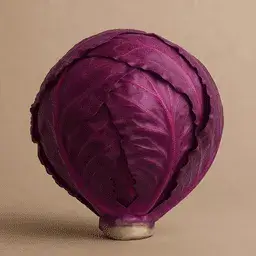
Red cabbage is a delicious vegetable with red-purple leaves. It can change color according to the pH value of the soil and is referred to with different colors in different parts of the world.
Red cabbage can be used raw in salads, eaten boiled, and is a popular side dish in German cuisine.
In addition, it can be used as a homemade pH indicator thanks to its color changing feature in acidic and basic solutions. Red cabbage is a healthy and nutritious option.
Eggplant

Eggplant, is a delicious fruit with a purple color and spongy texture. Although botanically a fruit, it is used as a vegetable in cooking. Eggplant, which is related to tomatoes, peppers and potatoes, is very popular in world cuisines.
Although its nutritional value is low, it easily absorbs oil and spices, adding a unique flavor to dishes. Eggplant can be found in a variety of shapes, sizes, and colors, but the most common are purple and elongated egg-shaped.
You can consume eggplant by making delicious meals with lots of vitamins, and you can serve it to children with recipes that they love to eat.
Purple Asparagus
Attracting attention with its purple color, Purple Asparagus is a delicious and healthy vegetable. It can be consumed both raw and cooked.
This special asparagus, which has a sweet and nutty flavor, is full of vitamins, strengthens the immune system and gives energy. You can prepare different and fun meals with this colorful vegetable that children will also love.
Concord grape
Concord grape is a dark blue or purple, large seeded and fragrant grape variety. It is generally used in making juice, jam and confectionery.
Also, juice made with Concord grapes is used in churches as a wine substitute. This delicious and colorful grape is perfect for desserts and drinks that kids will love too.
Purple Potatoes

Purple potatoes are a colorful and delicious vegetable variety. These potatoes, which have a purple color, dense and juicy interior, stand out with their sweet and nutty flavors.
Purple potatoes are a great choice for a healthy diet because they have antioxidant properties thanks to the anthocyanins they contain.
You can use purple potatoes by boiling, frying, baking or frying them. This fun and useful vegetable can be the star of the dishes that your kids will love too!
Birds
Purple Honeycreeper

Purple Honeycreeper is a small Neotropical bird belonging to the tanager family. It is found in the tropical New World from Colombia and Venezuela to Brazil and Trinidad.
Males are purple, with black wings and bright yellow legs, while females and juveniles have green upperparts and a cinnamon colored throat. These colorful birds living in the forest hills feed on fruit and nectar.
Costa’s Hummingbird
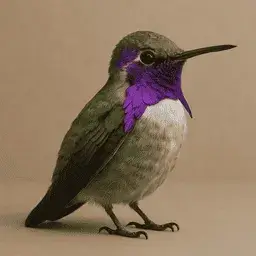
Costa’s Hummingbird is a tiny and colorful bird belonging to the Trochilidae family. They live in the southwestern United States and northwestern parts of Mexico.
The males have green backs and flanks, while their most distinctive feature is their bright purple head and throat. These fast and mobile birds feed on flower nectar and small insects they find in flowers.
Purple-backed Thornbill
The Purple-backed Thornbill is a colorful and cute hummingbird. It lives in countries such as Bolivia, Colombia, Ecuador, Peru and Venezuela.
It is about 8-9 cm in length and draws attention with its short, black bill. The males have a bright purple-black color, while the females have more greenish plumage.
These tiny birds feed by collecting nectar from tall trees and preying on air beetles. The purple-backed thorntail lives in tropical forests and mountainous regions and can move quite quickly.
Grey-headed Swamphen
The Grey-headed Swamphen is a colorful bird that lives in regions such as the Middle East, India, southern China, and northern Thailand.
Although initially considered a subspecies of purple water chicken, it was recognized as a full species in 2015. To impress their mates, male birds hold aquatic plants in their beaks and bow to the female and laugh loudly, making an interesting mating ceremony.
The gray-headed waterfowl began to be seen in Florida in the 1990s and has become one of the bird species of the region over time.
Purple-throated mountaingem
The Purple-throated Mountaingem is a colorful and cute hummingbird species. They live in Costa Rica, Nicaragua and Panama. These small birds are only 10-11.5 cm long and 4.5-6 grams in weight. The male purple-throated mountain jewel stands out for its bright green and purple colours, while the females are paler and appear hairy yellow on the throat and chest. These beautiful birds feed by sucking the nectar of flowers and also feed on insects. The purple-throated mountain jewel prefers to live in moist forests and cloud forests in mountainous regions.
Violet-backed Starling
The Violet-backed Starling is a 17 cm long and colorful bird that lives in various parts of Africa.
Males have a white body with a bright purple head and back, while females have brown and white-striped plumage.
This species prefers to live in trees and high above the ground. The Violet-backed Starling feeds on fruit, seeds and insects.
Purple Martin
The Purple Martin is North America's largest species of swallow. Not really purple, this bird has deep blackish-blue plumage that looks bright blue, dark blue, and deep purple due to the refraction of light. Fast and agile flyers, Violets feed mostly on insects and nest in tree cavities or special birdhouses built by humans.
Especially in the eastern regions, people provide artificial nests for these beautiful birds to live and breed.
Purple Grenadier
Purple grenadier is a colorful and cute bird found in eastern Africa. While the males have a cinnamon colored head and neck, they stand out with their blue eye contour and purple blue tail feathers. The females, on the other hand, are smaller and cinnamon brown in color, with silvery-blue eye contours. These beautiful birds inhabit dry bush areas especially in countries such as Ethiopia, Kenya, Somalia, South Sudan, Tanzania and Uganda.
Purple Starling
Purple starling is a species of starling that draws attention with its eye-catching plumage and lively appearance. Adults have a metallic purple head and body and green wings.
Living in tropical Africa, these cheerful and noisy birds are often found in woodlands and farmland. Feeding on both fruit and insects, purple starlings are social birds that like to live in groups.
Varied Bunting
Multicolored Varied Bunting birds are cheerful, singing creatures belonging to the cardinal family. These birds, which live from the southern regions of the USA to Mexico, attract attention with their bright colors and agile movements.
Varied Buntings, which choose thorny bushes for nesting, prefer insects, fruit and seeds as food. These birds, which cheer up their surroundings with their beauty and their songs, are a colorful part of nature.
Violet Sabrewing
Violet Sabrewing is a species of hummingbird with a bright purple color and fascinating appearance. It lives in areas from Mexico to Panama.
These fast and energetic birds feed on the nectar of flowers and insects. Violet Sabrewing, which is frequently seen on forest edges and gardens, adds color and movement to its surroundings.
Sea Creatures and Fish
Pisaster Ochraceus

Pisaster ochraceus, or purple starfish, is the colorful inhabitant of the Pacific Ocean. You know, the five-armed, cute star-shaped sea creature we see in cartoons!
Despite being purple in color, this starfish with different outfits such as orange, yellow and brown is the superhero of the sea. It maintains the balance of marine life by hunting shellfish and helps keep the undersea world healthy.
This interesting creature, watched with admiration by both children and adults, is the leading actor in the marine ecosystem.
Zebrasoma Xanthurum

Purple flippers are stylish sea creatures. Eye-catching with its purple body and yellow tail, this fish lives on coral reefs and cleans seaweed.
Zebrasoma xanthurum, which has a special appearance thanks to its long snout and large fins, both contributes to marine life and attracts the attention of children and adults.
Sphaerechinus Granularis
Purple sea urchins are interesting looking sea creatures. The spines of this sea urchin, which has two color types, can be purple or white. Sphaerechinus granularis, which lives in the Mediterranean and the eastern Atlantic Ocean, contributes to the health of the seas by feeding on seaweeds and algae.
Purple Rocks and Minerals
Amethyst
Amethyst is a purple variety of quartz and is a popular semi-precious stone for its beautiful appearance. This stone, which is often used in jewelry and believed to prevent drunkenness in ancient times, has an important place in history.
Sugilite
Sugilite is a rare pink and purple colored mineral. It is usually found in large masses and is used in jewelry. It is mined in different regions such as Japan, Canada, and South Africa. This stone, which has a hardness and a special appearance, can also be interesting for children. Sugilite is also known by names such as lavulite, luvulite, and royal azel.
Charoite
Charoite is a rare and fascinating silicate mineral. This stone, which has an unusual wavy and silky structure, is used in jewelry and ornaments.
Found only in the Siberian region of Russia, this interesting mineral can also captivate children, both in terms of beauty and color. Charoite is also known as charoite jade and lilac stone.
Grape Agate
Grape Agate is a purple botryoidal (grape cluster-like) chalcedony stone and has so far only been found in Indonesia. This leads to the fact that the stone is quite rare and valuable. Colors range from dark purple to light lilac and lavender tones.
The properties and structure of this stone are interesting in terms of mineralogy and geology. Scientifically, more research is needed on the formation and structure of Grape Agate. Such gemstones have an important economic value in terms of mining and management of natural resources.
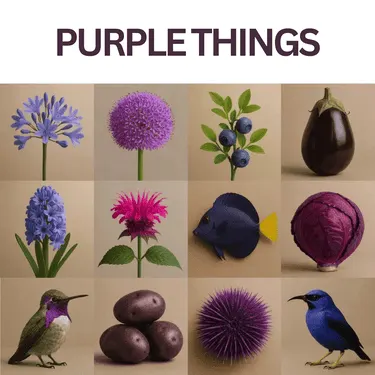
Other Articles Related With Purple: Purple Snacks, Purple Cartoon Characters